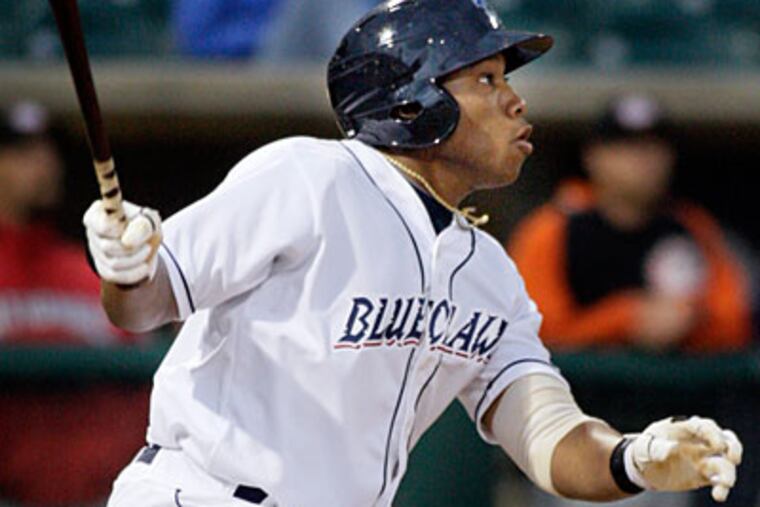No second-guessing here on Phils' trades
THE MAGIC formula that has propelled the Phillies from contender to World Series winner to baseball superpower, is 17=5. Seventeen minor league prospects (one still to be named) exchanged as needs arose for five extraordinary All-Star talents. Four are pitchers; one, the most recent acquisition, Hunter Pence, is an outfielder.

THE MAGIC formula that has propelled the Phillies from contender to World Series winner to baseball superpower, is 17=5.
Seventeen minor league prospects (one still to be named) exchanged as needs arose for five extraordinary All-Star talents. Four are pitchers; one, the most recent acquisition, Hunter Pence, is an outfielder.
All-Star Houston closer Brad Lidge for centerfielder Michael Bourn, corner infielder Mike Costanzo and righthanded pitcher Geoff Geary.
Cleveland Cy Young Award winner Cliff Lee for righthander Carlos Carrasco, catcher Lou Marson, infielder Jason Donald and righty Jason Knapp.
Future Hall of Fame righthander Roy Halladay from the Toronto Blue Jays for catcher Travis d'Arnaud, righthander Kyle Drabek and outfielder Michael Taylor.
All-Star righthanded pitcher Roy Oswalt from the Astros for lefthander J.A. Happ, outfielder Anthony Gose and shortstop Jonathan Villar.
Astros All-Star rightfielder Hunter Pence for righthander Jarred Cosart, first baseman Jonathan Singleton, righty Josh Zeid and a player-to-be-named.
Seventeen for five . . .
Philadelphians of my generation remember Pearl Harbor.
If you are of the next generation, you try to forget Vietnam and the Phillies' 1964 collapse - not always in that order.
If you are of this generation - Bailout Gen - you remember 9/11 and fear a rerun of the Great Depression your grandparents have told you about.
But all generations of living Philadelphia baseball fans share a genetic terror. They are afflicted by the dreaded What If chromosome. What if a number of these prospects turn into Ferguson Jenkins and/or Ryne Sandberg?
So what if they do?
Any student of baseball who lived through the terrible Jenkins and Sandberg deals will be happy to tell you the Phillies became so bad after those trades, neither Hall of Famer would have been enough to lift those bottom-feeders to the surface.
During the six seasons - 1967 through 1972 - where Fergie won 20 or more games for the Cubs, the Phillies were a total of 122 games under .500. Grover Cleveland Alexander or Robin Roberts in their primes would not have helped those wretched ball clubs. By the time the Phillies got good in the mid-'70s, Jenkins was an American Leaguer in his mid-30s.
When Paul Owens tossed Sandberg - who was blocked at his best positions by Manny Trillo and Mike Schmidt - into the Bill Giles-ordered Larry Bowa exile to Chicago, an era was ending. The Wheeze Kids were cooked, Giles had begun deconstructing the game's best farm system and the wolf was at the door.
Sandberg's rise to the National League's premier second baseman would have done little to help a Phillies team that in 1985 through 1992 played 100 games under .500. Sandberg could have hit like the 1930 Hack Wilson and he would not have been a difference-maker.
But, as this team starts showing some wrinkles, it is fair and genetically correct to ask: Who from this package can cause us to squeal in a couple of years: "How the hell could we have traded him?"
Here are the elite potential All-Star level haunters:
Bourn. "The Blur" is an All-Star and the NL's premier leadoff man, base stealer and centerfielder. The really bad news is he now leads off for the Atlanta Braves and could be inflicting anguish in October. But Lidge has already returned a World Series title.
D'Arnaud. The 6-2 catcher, a superb defender, is starting to grow into his power and is having an MVP-level season for the Eastern League's New Hampshire Fisher Cats. Yeah, but Charlie got Doc.
Gose. Also a Fisher Cat, Gose has Bourn-level speed and plays brilliant centerfield. His offense is starting to come around and this kid can be a top-of-the-lineup beast. The Jays would not have made the Halladay deal without him.
Singleton. Because he is so young, the strapping first baseman remains a work in progress, but the upside is there. He projects as an offensive first baseman who will cover his liabilities with raw power. At least that's the template. He has been mashing the ball for Lancaster in the advanced Class A California League. But he's now in the Astros minor league system, which is the worst in baseball and faces a total rebuild.
On the fence:
Carrasco. I never saw the big righthander as more than a No. 4. Carlos, who is just 24, is scuffling along at 8-9 for the Indians with a 4.55 ERA in 21 starts.
Happ. The 6-6 lefthander is back in Triple A, trying to sort out why he was 4-14 with a 6.26 ERA for Ed Wade in Houston; Happ is 28.
Cosart. Unless he rises to All-Star status, the hard-throwing righty won't be missed. Despite all the trades, the Phils' minor league system is loaded with live arms at almost every level. Julio Rodriguez just won No. 15 for Clearwater and has a chance to win 20. The organization brims with pitching talent. Power arms are wriggling out of the woodwork.
Taylor. I hung a "can't-miss" tag on the 6-5 outfielder when he was tearing up the minors for the Phillies. He's a huge man who hit a wall with Sacramento in the Pacific Coast league while battling nagging injuries and his hard-to-control juvenile diabetes.
Drabek. Awful numbers since his demotion by the Blue Jays. Bad enough to suggest the lead pony in the Halladay deal is headed for his second Tommy John.
As for the rest, there is nobody who will be missed. So enjoy the dynasty while it lasts.
Don't worry, be happy . . .